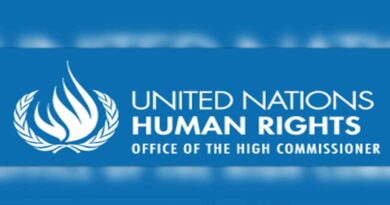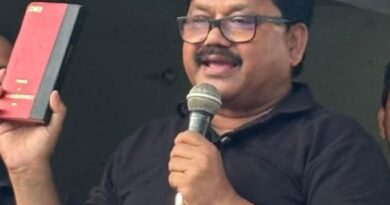Constitution Day Marks Renewal of Shared National Ideals, Not Formality: Justice Vikram Nath
(By Syed Ali Taher Abedi)
At the Constitution Day celebrations held at the Supreme Court on 26 November Justice Vikram Nath delivered his speech. Justice Vikram Nath’s words on Constitution Day did not merely open a formal ceremony; they unfurled like a charge to the conscience of the Republic. In the high-domed hall of the Supreme Court, under the austere gaze of the Ashokan lions, his welcome address transformed November 26 from a date on the calendar into a testimony of faith in constitutionalism. Before him sat President Draupadi Murmu, the Chief Justice of India Surya Kant, judges, law officers and members of the Bar, but his real audience was far wider: the citizens in whose name the Constitution speaks.
“We are deeply honoured by the gracious presence of the Hon’ble President of India, Smt. Droupadi Murmu, whose august office reminds us of the democratic ideals and constitutional values that guide our Republic.”
The court in solemn assembly
The morning air in the Supreme Court bore the familiar hush that precedes significant constitutional moments. The gathering was ceremonial in appearance, but the mood was reflective, almost meditative. The flags were in their place, the dais set, the protocol impeccable. Yet, as Justice Vikram Nath rose to deliver his welcome address, it was clear he intended to gently disturb any complacency that ceremony might bring. This, he suggested, was not a morning for mere ritualistic reminiscence, but for renewal.
“In a nation as vast and varied as ours, the Constitution acts as both compass and anchor. It provides stability to institutions and protection to the weakest among us, even as it adapts to new demands and new generations without losing sight of its foundational values.”
He began by underscoring that the observance of November 26 must never be reduced to a perfunctory annual exercise. To treat Constitution Day as a box to be ticked, he implied, would be to betray the document it seeks to honour. The day, he said, must remain an active reaffirmation of the constitutional values that bind the nation—values that do not rest in glass cases or museum halls, but move with every citizen who believes in justice, liberty, equality and fraternity. In his cadence, the phrase “Constitution Day” shed any festive superficiality and acquired the weight of an oath.
A living promise, compass and anchor
Turning to the text that lay at the heart of the celebration, Justice Nath spoke of the Constitution not as an inert statute-book but as a “living promise”. In his telling, it was not merely a compilation of Articles and Schedules, but a continuing assurance that the Republic gives to all who dwell within its borders. It is, he observed, both compass and anchor: the compass that points the nation towards a just and inclusive future, and the anchor that steadies its institutions in times of turbulence and change.
He reminded the assembled gathering that within this framework India has pursued justice in its broadest sense, nurtured pluralism amidst extraordinary diversity, and ensured that every citizen is vested not only with rights but with corresponding responsibilities. In a country as vast and varied as India, the Constitution, he suggested, is the quiet but constant presence that protects the weakest, disciplines the strongest, and creates a common language of legitimacy. The rule of law, in his narrative, was not an abstraction but the lived experience of millions whose only shield is that very promise.
Justice Nath then turned, with deliberate grace, to the dignitaries seated before him. In President Draupadi Murmu, he said, the nation beholds more than the occupant of the highest constitutional office; it sees a life story that exemplifies resilience, compassion and inclusive leadership. Her journey from some of the most marginalised corners of India to Rashtrapati Bhavan stands, he suggested, as a reminder of the transformative potential of democratic institutions when they are allowed to function with openness and fairness.
He warmly commended the President’s decades of service, particularly her work for the health, education and economic empowerment of tribal communities. In this, he wove her personal narrative into the broader fabric of constitutional morality, portraying her as both beneficiary and guardian of the values enshrined in the Preamble. Turning to Chief Justice Surya Kant, Justice Nath expressed confidence that the judiciary would continue to be guided by a leadership rooted in institutional integrity, accessibility and efficiency—a leadership that treats justice not as an elite privilege but as a public service owed to every litigant who approaches the court.
Bar, Bench and the task of reform
No Constitution Day reflection could be complete without reference to the intricate relationship between the Bar, the Bench and the executive. Justice Nath acknowledged the presence and efforts of the Minister of State for Law and Justice, Arjun Ram Meghwal, recognising his role in fostering dialogue between the legal profession, the judiciary and the Government. Such dialogue, he indicated, is not a matter of courtesy but an essential ingredient of a functioning constitutional democracy, particularly when legal reforms seek to keep pace with social change.
By commending the Minister’s work in driving reforms, Justice Nath subtly underlined that the Constitution is not self-executing. It requires institutions that talk to each other rather than past each other, and that remain willing to refine procedures, reduce delays, and expand access. In his remarks, one could hear an insistence that the health of the Republic depends on the strength of all its constitutional organs acting in concert, each within its sphere, yet all united by a common fidelity to the basic structure of the document that created them.
The legacy of 26 November 1949
The judge then invited the audience to travel back in time to November 26, 1949, when the Constituent Assembly adopted the Constitution of India. That moment, Justice Nath said, marked an extraordinary act of collective vision by a newly independent nation. Emerging from the long shadows of colonial rule, India did not choose the path of authoritarian certainty; it consciously chose democratic values for its future, entrusting ultimate power not to a monarch or a dictator, but to “We, the people”.
In recalling that adoption, he was not merely offering a history lesson. He was reminding the nation that every Article was debated, contested and crafted with the expectation that future generations would guard it with care. Constitution Day, in his formulation, is therefore not only an anniversary of adoption but a periodic audit of fidelity—an occasion for the present generation to ask whether it has been worthy of the faith reposed by the framers. To forget that provenance, he implied, is to risk treating hard-won freedoms as inherited entitlements rather than as responsibilities.
Citizens at the heart of the constitutional order
From history, Justice Nath moved seamlessly to the citizen. Constitution Day, he highlighted, is a reminder of the rights and responsibilities vested in every individual. Rights, in his articulation, are not concessions made by the State but guarantees that define the legitimacy of State power itself. Yet, he was careful to place alongside these rights the equally vital notion of civic duty—respect for the law, tolerance of difference, and participation in democratic processes that keep institutions accountable.
The Constitution, he suggested, calls upon citizens to be more than passive recipients of State action. It asks them to be co-authors of the Republic’s ongoing story, ensuring that the values of liberty, equality and fraternity are not confined to courtrooms and law reports but are reflected in everyday conduct. In that sense, Constitution Day becomes less about speeches delivered from podiums and more about quiet choices made in homes, workplaces and streets across the country.
The Supreme Court’s interpretative humility
Reaffirming the Supreme Court’s constitutional role, Justice Nath spoke with measured seriousness about the Court’s interpretative responsibilities. The Court, he said, approaches its task with humility and care, conscious that its decisions are not academic exercises but pronouncements that shape the daily realities of millions. Each interpretation of a constitutional provision can determine whether a fundamental right is expanded, narrowed or meaningfully enforced.
In that spirit, he portrayed the Court as the guardian, not the owner, of the Constitution. Judicial review, he implied, is a trust, not a privilege; it demands restraint as much as courage. The Court must listen— to arguments of counsel, to the text and structure of the Constitution, and to the silent voices of those whose fates are bound up in its judgments. In framing its duty this way, Justice Nath linked the grandeur of constitutional theory with the grounded ethics of judging.
A call beyond ritual
As the address drew towards its close, the atmosphere in the hall felt less like the end of a ceremony and more like the beginning of a renewed covenant. Justice Vikram Nath’s central theme returned with quiet insistence: November 26 cannot be allowed to fossilise into empty ritual. The garlands, the dais, the formalities—all have their place, but they are means, not ends. The true observance lies in the daily reaffirmation of the shared values that bind the people of India together despite their differences.
Under the soft lights of the Supreme Court auditorium, amid the rustle of robes and files, his words left an unmistakable echo: the Constitution will remain a living promise only if those who live under it choose, again and again, to make it so. In that sense, Constitution Day is not merely a date to be marked, but a question to be answered—by judges and lawyers, by lawmakers and administrators, and above all, by citizens whose quiet and steadfast commitment keeps the grand edifice of the Republic standing tall.




